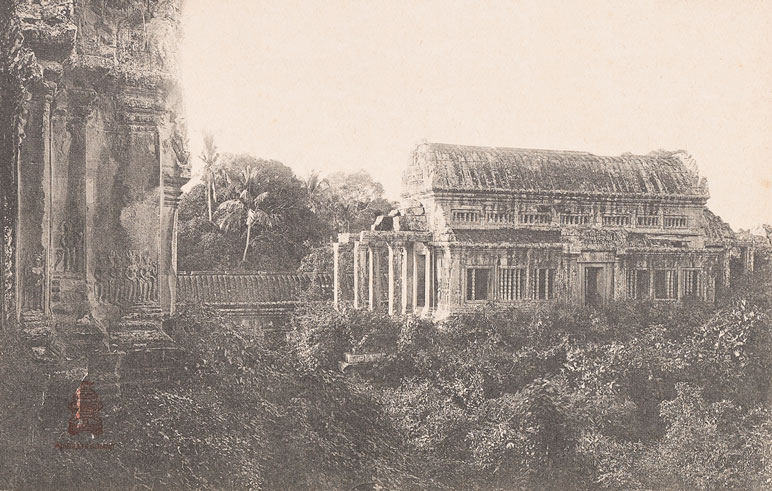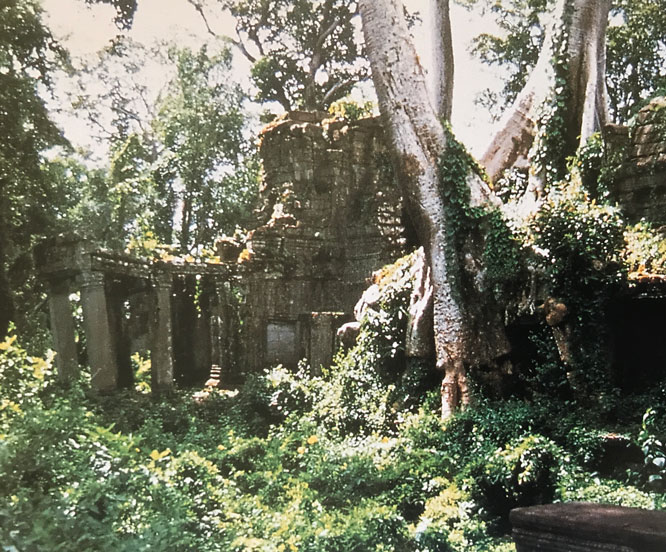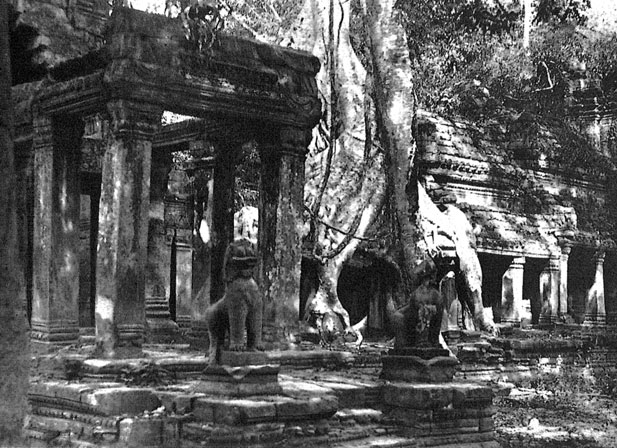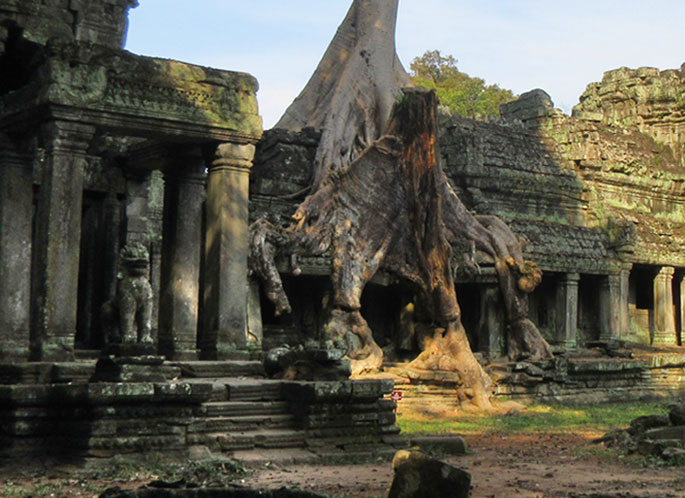Whole
Enjungled
Cities
by Joshua Humphreys
AUTHOR | GALLIVANTER | PANGOLIN

Whole Enjungled Cities
by Joshua Humphreys
AUTHOR | GALLIVANTER | PANGOLIN

joshua humphreys, writer, author, "joshua humphreys writer", "joshua humphreys author", Australia, comedy novels, novelist, funny, Australian, writer, joshua, humphreys, funniest books, exquisite hours, the creative art of wishfulness, Preah Khan, Grieve, comedy novel, siem reap, angkor wat, joshua humphreys
“THE CITY OF THE KING OF THE ANGELS—
that which once counted a hundred and twenty kings
under tribute and put into the field an army of five million men,
whose wealth was built upon the sapphire feathers of the halcyon kingfisher,
a temple indebted for its splendour to the greatness of the Leper King
and at whose centre lay the Hall Of A Thousand Gods:
its once-gilded towers the work of zealous giants
or said even to have built themselves…”
“THE CITY OF THE KING OF THE ANGELS—
that which once counted a hundred and twenty kings under tribute and put into the field an army of five million men, whose wealth was built upon the sapphire feathers of the halcyon kingfisher, a temple indebted for its splendour to the greatness of the Leper King and at whose centre lay the Hall Of A Thousand Gods: its once-gilded towers the work of zealous giants or said even to have built themselves…”

Angkor Wat was built in the first half of the 1100s, halfway between what are now Bangkok & Saigon by a people called the Khmer.
The passage above contains some of the myths to which the locals once attributed its construction.
Sacked almost immediately by the Chams from the east, it was abandoned as imperial capital & gradually turned from a Hindu into a Buddhist place of worship.
Still today it is the largest religious building in the world.
Angkor Wat was built in the first half of the 1100s,
halfway between what are now Bangkok & Saigon
by a people called the Khmer.
The passage above contains some of the myths
to which the locals once attributed its construction.
Sacked almost immediately by the Chams from the east,
it was abandoned as imperial capital & gradually turned
from a Hindu into a Buddhist place of worship.
Still today it is the largest religious building in the world.



The temple's centre seen from the doorway of an outer hall, John Thomson, 1866

The temple's centre viewed from 3/4 along the western causeway, 2020

In 1860 the French naturalist and explorer Henri Mouhot visited the ruins and in his Travels in Siam, Cambodia & Laos introduced them to Europe:
"In the province still bearing the name of Angkor there are, on the banks of the Mekong, ruins of such grandeur that at first view one is filled with profound admiration.
One of these temples—a rival to that of Solomon, and erected by some ancient Michelangelo—might take an honourable place beside our most beautiful buildings and is grander than anything left to us by Greece or Rome."
In 1860 the French naturalist and explorer Henri Mouhot visited the ruins and in his Travels in Siam, Cambodia & Laos
introduced them to Europe:
"In the province still bearing the name of Angkor there are, on the banks of the Mekong, ruins of such grandeur that at first
view one is filled with profound admiration.
One of these temples—a rival to that of Solomon, and erected by some ancient Michelangelo—might take an honourable place beside
our most beautiful buildings and is grander than
anything left to us by Greece or Rome."


John Thomson's westerly view from the central gallery in 1866.

Joshua Humphreys' westerly view from the central gallery in 2019.

In 1866 a Scottish photographer blessed with the enthralling name of John Thomson spent 2 weeks here with his iPhone 5 & captured the very first photographs of the enjungled ruins.
Later that year a stinky Frenchman by the silly name of Émile Gsell copied him, but with an iPhone 6 Plus.
In 2015 a comedy novelist with the perfectly reasonable name of Joshua Humphreys visited Siem Reap to scout the city as a possible setting for his third novel.
He also had an iPhone but is too embarrassed to mention which model.
In 1866 a Scottish photographer blessed with the enthralling name of
John Thomson spent 2 weeks here with his iPhone 5 & captured
the very first photographs of the enjungled ruins.
Later that year a stinky Frenchman by the silly name of
Émile Gsell copied him, but with an iPhone 6 Plus.
In 2015 a comedy novelist with the perfectly reasonable name of Joshua Humphreys
visited Siem Reap to scout the city as a possible setting for his third novel.
He also had an iPhone but is too embarrassed to mention which model.


The northern library of Angkor Wat in 1866, photographed by Émile Gsell.

The northern library of Angkor Wat in 2019, photographed by me.

Since that first scouting visit in 2015 I have returned four times to Siem Reap and the ruins of Angkor.
As well as being pretty much the warmest place on earth, it is also one of the most unique, the most enthralling, the most breathtaking.
Mouhot again:
"To obtain any idea of its splendor, one must imagine the most beautiful creations of architecture transported into the depths of the forest in one of the most remote countries of the world."
Since that first scouting visit in 2015 I have returned
four times to Siem Reap and the ruins of Angkor.
As well as being pretty much the warmest place on earth,
it is also one of the most unique, the most enthralling, the most breathtaking.
Mouhot again:
"To obtain any idea of its splendor, one must imagine
the most beautiful creations of architecture transported
into the depths of the forest in one of the
most remote countries of the world."


The southern Library floating upon a sea of jungle, from a French postcard, 1922.

The southern Library momentarily not covered in Chinese tourists, 2016.

As you can see from the early pictures,
150 years ago the forest still was thriving,
and I think it's a shame that they have now so cleared it.
While Angkor Wat is for most people the centrepiece of their visit,
— and it is certainly magnificent —
it is by no means the most exquisite place that you can see in Siem Reap.
For 4 miles due north there crumbles beneath the jungle another temple...
As you can see from the early pictures, 150 years ago the forest still was thriving,
and I think it's a shame that they have now so cleared it.
While Angkor Wat is for most people the centrepiece of their visit,
— and it is certainly magnificent —
it is by no means the most exquisite place that you can see in Siem Reap.
For 6 kilometres due north there crumbles beneath the jungle another temple...

The main entrance to Preah Khan, dusty at the end of dry season, 2016.

"THE HOLY CITY OF VICTORY—first Khmer temple with which Hector had fallen in love, that triumphant citadel built to honour his father by Jayavarman VII over the battleground on which he defeated the Cham invaders; where were more guardians of holy places than at any other Cambodian temple—that Holy Sword onto whose roof at dawn Hector Grieve often climbed and there among birdsong contemplated the desuetude of a whole crumbling city covered in turquoise."
"THE HOLY CITY OF VICTORY—first Khmer temple with which Hector had fallen in love,
that triumphant citadel built to honour his father by Jayavarman VII
over the battleground on which he defeated the Cham invaders;
where were more guardians of holy places than at any other Cambodian temple—
that Holy Sword onto whose roof at dawn Hector Grieve often climbed
and there among birdsong contemplated the desuetude of
a whole crumbling city covered in turquoise."


The author before Preah Khan's eastern, hall-strangling, spung trees.

The same corner in 1992, just after it had been cleared of Khmer Rouge landmines
and before restoration work began a second time.

In 1191 the Khmer and their god-king defeated a Cham invasion (so pesky these Chams) and on the site of the final battle they built a temple-city.
Flip-flopping for a century between Hinduism and Buddhism, its interior was once plated entirely in bronze & housed 100,000 priests, dancers, and attendants.
Today its ruins are called Preah Khan.
Still partially unrestored and in places overtaken by jungle, it is the most splendid edifice at Angkor, and one of the most enchanting places on earth.
In 1191 the Khmer and their god-king defeated a Cham invasion (so pesky these Chams)
and on the site of the final battle they built a temple-city.
Flip-flopping for a century between Hinduism and Buddhism,
its interior was once plated entirely in bronze & housed
100,000 priests, dancers, and attendants.
Today its ruins are called Preah Khan.
Still partially unrestored and in places overtaken by jungle,
it is the most splendid edifice at Angkor,
and one of the most enchanting places on earth.


The eastern entrance to Preah Khan, 1939.

The eastern entrance to Preah Khan, 2017.
(Notice they've lost a lion since the previous photograph).

A short video superimposing the 1866 photos over the 2019 photos, as well as some contraband footage of Preah Khan at dawn!
A short video superimposing the 1866 photos over the 2019 photos,
as well as some contraband footage of Preah Khan at dawn!


Osbert Sitwell visited in 1939:
"Nature and art are engaged everywhere in ferocious battle or merge in wild and inextricable confusion. Trees sprout like antlers from the heads of gods; lions and gryphons, as though they were alive, peer through the fluttering screens of leaves. The prone image of the Buddha is being gradually raised from the ground by the force of the plants beneath his weight, & nearby a stone Siva, destroyer and creator, is, in his turn, being destroyed by his creations."
Indeed.

Osbert Sitwell visited in 1939:
"Nature and art are engaged everywhere in ferocious battle or merge in wild and inextricable confusion.
Trees sprout like antlers from the heads of gods; lions and gryphons, as though they were alive,
peer through the fluttering screens of leaves. The prone image of the Buddha is being gradually
raised from the ground by the force of the plants beneath his weight, & nearby a stone Siva,
destroyer and creator, is, in his turn, being destroyed by his creations."
Indeed.


Its southern half is almost completely returned to nature.
There, mounds of dirt enable one (if one's there before the security guards)
to scale the 12-foot walls and listen to a Mahler-symphony of tropical birdsong
while overlooking the entire dawn-lit complex of sticky black and grey and turquoise.
Within, tightly-packed priestly villages wallpapered with lichen dance with apsaras and hush with sculpted monks, each and every doorway flanked by two dvarapala—"guardians of holy places".
And then, its eastern entrance!
Its southern half is almost completely returned to nature.
There, mounds of dirt enable one (if one's there before the security guards)
to scale the 12-foot walls and listen to a Mahler-symphony of tropical birdsong
while overlooking the entire dawn-lit complex of sticky black and grey and turquoise.
Within, tightly-packed priestly villages wallpapered with lichen dance with apsaras and hush with sculpted monks, each and every doorway flanked by two dvarapala—"guardians of holy places".
And then, its eastern entrance!


The flaming pediments, the spiny galleries dropping from a decapitated gopuram
—half of it squeezed by tree roots as though by enormous fingers— out to a square portico with worn and greenest lintel, a singha after 1000 years still roaring at its post, all shaded by banyan.
Behind it, within the temple proper,
a 2-storey library and a Hall of Dancers, the naga balustrades and uncountable shades of mauve upon whole walls carved with delicate flame-lick foliage growing from grinning Kala, time—devourer of all things—and with rows & rows of bodhi tree, the sculptors not thinking that ever would their effort to bring the forest to art be so pointless, for so soon would the forest come to it.
There is nowhere else on earth like Preah Khan, and I urge everyone visiting Siem Reap to devote hours exclusively to its hot and fading stones.
It is an education in aesthetics, an Indiana-Jones-stroll through history, & a reminder of what human beings could create—
if only they would.
The flaming pediments, the spiny galleries dropping from a decapitated gopuram
— half of it squeezed by tree roots as though by enormous fingers —
out to a square portico with worn and greenest lintel, a singha after
1000 years still roaring at its post, all shaded by banyan.
Behind it, within the temple proper,
a 2-storey library and a Hall of Dancers, the naga balustrades
and uncountable shades of mauve upon whole walls carved with delicate flame-lick foliage
growing from grinning Kala, time—devourer of all things—and with rows & rows of bodhi tree,
the sculptors not thinking that ever would their effort
to bring the forest to art be so pointless,
for so soon would the forest come to it.
There is nowhere else on earth like Preah Khan, and I urge everyone
visiting Southeast Asia to devote hours exclusively to its hot and fading stones.
It is an education in aesthetics, an Indiana-Jones-stroll through history,
& a reminder of what human beings could create—if only they would.


If ever you're planning a visit to Siem Reap, as well spending hours at Angkor Wat and Preah Khan, be sure to wander around the Bayon and Ta Phrom, and to venture out to Banteay Samré and the Bakhong.
My one piece of advice is to stay away from the temporal tourist route.
The best way to do so is to counter their very predictable movements.
Universally they go to Angkor Wat for sunrise then head to Angkor Thom then Ta Phrom. They enfatten themselves in the middle of the day then return to Banteay Kdei in the afternoon then either to Phnom Bakheng or Pre Rup for the sunset.
But you! Leisured lynx of a traveller!
YOU race to Preah Khan's eastern entrance in the early morning (at sunrise if you're game enough to sneak in) and leave Angkor Wat for the middle of the day, when you'll have both an outdoor sweat-sauna AND the world's largest religious building practically to yourself.
And you will forget about sunsets surrounded by loogie-hocking selfie-takers and watch it over Srah Srang or the northern moat of Angkor Thom.
And you'll spend at least 5 days doing so.
If ever you're planning a visit to Siem Reap, as well spending hours at Angkor Wat and Preah Khan,
be sure to wander around the Bayon and Ta Phrom, and to venture out to Banteay Samré and the Bakhong.
My one piece of advice is to stay away from the temporal tourist route.
The best way to do so is to counter their very predictable movements.
Universally they go to Angkor Wat for sunrise then head to Angkor Thom then Ta Phrom.
They enfatten themselves in the middle of the day then return to Banteay Kdei in the afternoon
then either to Phnom Bakheng or Pre Rup for the sunset.
But you! Leisured lynx of a traveller!
YOU race to Preah Khan's eastern entrance in the early morning
(at sunrise if you're game enough to sneak in)
and leave Angkor Wat for the middle of the day, when you'll have both an outdoor sweat-sauna
AND the world's largest religious building practically to yourself.
And you will forget about sunsets surrounded by loogie-hocking selfie-takers
and watch it over Srah Srang or the northern moat of Angkor Thom.
And you'll spend at least 5 days doing so.


I did end up setting the opening of my third novel there.
That book is called Grieve, and follows the exploits of Hector S. Grieve—
a hellraising soldier of fortune who protects on horseback these Cambodian ruins from looters.
Its opening scene takes place at Angkor Wat at sunrise; he gives his Cambodian farewell speech at Preah Khan.
For Hector is quickly forced to return home to Melbourne, where instead of 1000-year-old temples & picturesque ruins he has to live in constant frustration among self-serve checkouts, jaywalking fines & his uninspiring childhood friends.
In order to save his dying father and win back his high school sweetheart Hector is inspired by his Cambodian adventures to become a kind of modern Robin Hood—and resolves to rob a bank vault containing a reserve of the combined wealth of Australia's billionaires...
I did end up setting the opening of my third novel there.
That book is called Grieve, and follows the exploits of Hector S. Grieve—
a hellraising soldier of fortune who protects on horseback these Cambodian ruins from looters.
Its opening scene takes place at Angkor Wat at sunrise;
he gives his Cambodian farewell speech at Preah Khan.
For Hector is quickly forced to return home to Melbourne,
where instead of 1000-year-old temples & picturesque ruins
he has to live in constant frustration among self-serve checkouts,
jaywalking fines & his uninspiring childhood friends.
In order to save his dying father and win back his high school sweetheart
Hector is inspired by his Cambodian adventures to become a kind of modern Robin Hood—
and resolves to rob a bank vault containing a reserve of
the combined wealth of Australia's billionaires...

It is a story of change, anger, & action.
It is a story of change, anger, and action.
And if Exquisite Hours
is champagne,
GRIEVE is hallucinogenic whiskey on the cantankerous rocks.
And if Exquisite Hours is champagne,
GRIEVE is hallucinogenic whiskey on the cantankerous rocks.



